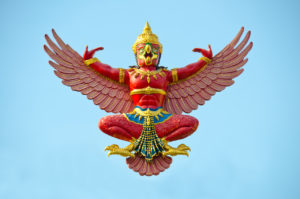
by Barrie
Today I have a short practice for exploring Eagle pose. The sequence focuses on the lower and upper body work separately and then it puts them together in the full pose. I offer simple warmups, prop variations, and modifications to make this pose more accessible and enjoyable to practice.
Garudasana is such an interesting and unusual pose. It’s a balancing pose, and as such it has all the strengthening and stabilizing benefits that come from standing on one leg. It’s also a very twisted pose, the only pose form where both the arms and legs are intertwined and wrapped around the front body.
The bind of the arms always does wonders for my upper back in the way it releases the very top of the trapezius muscle, that ridge at the base of the neck where many of us might scrunch up and hold tension. After practicing this pose, you might feel your shoulders relaxing away from your ears and that upper ridge becoming broader and more relaxed.
Both of these together, the balance element as well as the closing off of the front body to some degree because of the binding of the arms and legs, make it a great pose for cultivating one-pointed focus, developing greater presence of mind, and centering our attention inside.
What’s also interesting is that on the one hand it fosters this focus and one-pointedness by drawing our energy and attention inside, but at the same time it also fosters a quality of space and freedom and expansiveness in the back body.
This is because Eagle pose opens, awakens, and brings awareness to the back body. And we see a similar “bird back” form, in other bird poses like Crow pose (Bakasana), Peacock pose (Mayurasana), and even Heron pose (Kraunchasana.) So you can think of the broadening of the back of the ribcage and widening of the shoulder blades as a bird-like expanse across the back body that creates lightness and freedom.
Moving into the back body can also be about what you fall back on—who and what has your back—so to speak, and what supports you. And in this regard, the symbolism of the name of the pose is significant.
Garudasana is named for Garuda, a huge birdlike creature in Indian mythology. In fact, he is king of the birds. He has the power to go anywhere. He has the face of a man, red wings, and an eagle’s beak. Garuda is the vehicle of Lord Vishnu. In the Hindu pantheon, Vishnu is the sustaining power of the universe. He’s the protector, the all-pervasive power that maintains the universe. Like Vishnu, Garuda is also considered a protector.
In the Tibetan tradition, it’s said that Garuda flies and flies and flies. He never lands and he never gets tired because he rides the wind. It’s a great metaphor for taking the support of the powers that sustain us, and how we connect with the sustaining power of life to recharge our batteries and keep going.
Consider the powers that support and sustain you. The vital power in the breath, the food you eat, rest, activity, and so on. Beyond all the many things that sustain you on a physical level, what supports you on a mental, emotional, and spiritual level? What are the things, people, and activities that feed you? What are the constants in your life that you rely on? What keeps you going?
As you practice the pose, you can tune in to the sustaining power of life, the prana that moves through the senses, pulsates in our breathing, and powers our attention. You can connect to that sustaining power, harnessing the spirit that surrounds and supports us as we move in our practice and in our lives.
As you do so, it’s a great occasion to recognize and honor all the things you rely on, all that sustains your life with constancy—the food you eat, your surroundings, your loved ones, your friends, and your family. Acknowledge with appreciation all the many people, things, and activities that sustain you, physically, mentally, emotionally, and spiritually.
Props needed: 1 block, 1 strap, small amount of wall space (optional)
Download Barrie’s free Guide to Home Yoga Practice right here. Learn more about her book Evolving Your Yoga: Ten Principles for Enlightened Practice and her online classes at www.barrierisman.com.
Follow Yoga for Healthy Aging on Facebook ° To order Yoga for Healthy Aging: A Guide to Lifelong Well-Being, go to Amazon, Shambhala, Indie Bound or your local bookstore.


Leave A Comment